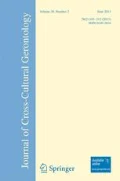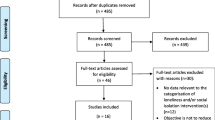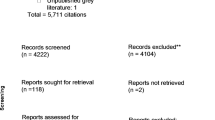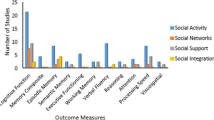Abstract
Cross-cultural research has shown marked variation in health outcomes across the world’s older adult populations. Indeed, older adults in the Circumpolar North experience a variety of health disparities. Because aging is a biological process rooted in sociocultural context, there exists great variation in the ways older adults define and experience healthy, or “successful,” aging in their communities. The aim of this analysis was to synthesize qualitative research among older residents (aged 50+ years) in the Circumpolar North to identify a definition of healthy aging common in the region. A thorough review was conducted across a variety of academic search databases for peer-reviewed, qualitative studies conducted among community-dwelling older adults. The search strategy initially identified 194 articles; 23 articles met the inclusion criteria. Included studies were coded and analyzed using Grounded Theory to examine underlying themes of healthy aging in the Circumpolar North. The findings reveal the importance older adults place on respect, their relationship to the land, and psychosocial resilience into multidimensional models of healthy aging. This research also highlights the need for increased translational research with populations in the Circumpolar North that are under-represented in the literature.

Similar content being viewed by others
References
Abarca-Gómez, L., Abdeen, Z. A., Hamid, Z. A., Abu-Rmeileh, N. M., Acosta-Cazares, B., Acuin, C., Adams, R. J., Aekplakorn, W., Afsana, K., & Aguilar-Salinas, C. A. (2017). Worldwide trends in body-mass index, underweight, overweight, and obesity from 1975 to 2016: A pooled analysis of 2416 population-based measurement studies in 128· 9 million children, adolescents, and adults. The Lancet, 390(10113), 2627–2642.
Abass, K., Emelyanova, A., & Rautio, A. (2018). Temporal trends of contaminants in Arctic human populations. Environmental Science and Pollution Research, 25(29), 28834–28850. https://doi.org/10.1007/s11356-018-2936-8.
Akearok, G. H., Stoor, J., Kanayurak, N., Rink, E., Emelyanova, A., Larsen, C., Cueva, K., & Hiratsuka, V. (2019). Exploring the term “resilience” in Arctic health and well-being using a sharing circle as a community-centered approach: Insights from a conference workshop. Social Sciences, 8(2), 45. https://doi.org/10.3390/socsci8020045.
Aslaksen, I., Dallmann, W., Holen, D. L., Høydahl, E., Kruse, J., Stapleton, M., & Turi, E. I. (2008). Interdependency of subsistence and market economies in the Arctic. The Economy of the North, 2007, 75–98. https://doi.org/10.1684/pnv.2011.0285.
Bacsu, J., Jeffery, B., Abonyi, S., Johnson, S., Novik, N., Martz, D., & Oosman, S. (2014). Healthy aging in place: Perceptions of rural older adults. Educational Gerontology, 40(5), 327–337. https://doi.org/10.1080/03601277.2013.802191.
Bardage, C., Pluijm, S. M. F., Pedersen, N. L., Deeg, D. J. H., Jylhä, M., Noale, M., Blumstein, T., & Otero, Á. (2005). Self-rated health among older adults: A cross-national comparison. European Journal of Ageing, 2(2), 149–158. https://doi.org/10.1007/s10433-005-0032-7.
Bauger, L., & Bongaardt, R. (2016). The lived experience of well-being in retirement : A phenomenological study. International Journal of Qualitative Studies on Health and Well-Being, 11, 33110. https://doi.org/10.3402/qhw.v11.33110.
Begum, S., & Naskali, P. (2016). Challenges to the human security of elderly Sámi in Finnish and Swedish Lapland. In: K. Hossain and A. Petretei (Eds.), Understanding the Many Faces of Human Security: Perspectives of Northern Indigenous Peoples (pp. 211–229). Netherlands: Brill Nijhoff.
Bernard, H. R. (2006). 2006 Research methods in anthropology (4th ed.). New York: AltaMira.
Bigonnesse, C., Beaulieu, M., & Garon, S. (2014). Meaning of home in later life as a concept to understand older adults’ housing needs: Results from the 7 age-friendly cities pilot project in Québec. Journal of Housing for the Elderly, 28(4), 357–382. https://doi.org/10.1080/02763893.2014.930367.
Bjerregaard, P., & Dahl-Petersen, I. K. (2011). How well does social variation mirror secular change in prevalence of cardiovascular risk factors in a country in transition? American Journal of Human Biology, 23(6), 774–779. https://doi.org/10.1002/ajhb.21209.
Boudiny, K. (2013). ‘Active ageing’: From empty rhetoric to effective policy tool. Ageing and Society, 33(6), 1077–1098. https://doi.org/10.1017/S0144686X1200030X.
Bourque, F., & Cunsolo Willox, A. (2014). Climate change: The next challenge for public mental health? International Review of Psychiatry, 26(4), 415–422. https://doi.org/10.3109/09540261.2014.925851.
Bowling, A. (2005). Ageing well: Quality of life in old age. Maidenhead: Open University Press.
Bowling, A. (2006). Lay perceptions of successful ageing: Findings from a national survey of middle aged and older adults in Britain. European Journal of Ageing, 3(3), 123–136. https://doi.org/10.1007/s10433-006-0032-2.
Bowling, A., & Dieppe, P. (2005). What is successful ageing and who should define it? BMJ (Clinical Research Ed.), 331(7531), 1548–1551. https://doi.org/10.1136/bmj.331.7531.1548.
Bratman, G. N., Hamilton, J. P., & Daily, G. C. (2012). The impacts of nature experience on human cognitive function and mental health. Ann N Y Acad Sci, 1249, 118–136. https://doi.org/10.1111/j.1749-6632.2011.06400.x.
Bratman, G. N., Daily, G. C., Levy, B. J., & Gross, J. J. (2015). The benefits of nature experience: Improved affect and cognition. Landscape and Urban Planning, 138, 41–50.
Brega, A. G., Ang, A., Vega, W., Jiang, L., Beals, J., Mitchell, C. M., Moore, K., Manson, S. M., Acton, K. J., & Roubideaux, Y. (2012). Mechanisms underlying the relationship between health literacy and glycemic control in American Indians and Alaska natives. Patient Education and Counseling, 88(1), 61–68. https://doi.org/10.1016/J.PEC.2012.03.008.
Brown, S. C., Lombard, J., Wang, K., Byrne, M. M., Toro, M., Plater-Zyberk, E., Feaster, D. J., Kardys, J., Nardi, M. I., Perez-Gomez, G., Pantin, H. M., & Azapocznik, J. (2016). Neighborhood greenness and chronic health conditions in Medicare beneficiaries. American Journal of Preventive Medicine, 51(1), 78–89.
Card, N. A. (2015). Applied meta-analysis for social science research. New York: Guilford Publications.
Carlson, M. C., Seeman, T., & Fried, L. P. (2000). Importance of generativity for healthy aging in older women. Aging Clinical and Experimental Research, 12(2), 132–140. https://doi.org/10.1007/BF03339899.
Charles, S. T., & Carstensen, L. L. (2010). Social and emotional aging. Annual Review of Psychology, 61, 383–409. https://doi.org/10.1146/annurev.psych.093008.100448.
Charmaz, K. (2006). Constructing grounded theory: A practical guide through qualitative analysis. Thousand Oaks: Sage.
Collings, P. (2000). Aging and life course development in an Inuit community. Arctic Anthropology, 37(2), 111–125.
Collings, P. (2001). “If you got everything, it’s good enough”: Perspectives on successful aging in a Canadian Inuit community. Journal of Cross-Cultural Gerontology, 16(2), 127–155. https://doi.org/10.1023/A:1010698200870.
Cosco, T. D., Prina, A. M., Perales, J., Stephan, B. C. M., & Brayne, C. (2013). Lay perspectives of successful ageing: A systematic review and meta-ethnography. BMJ Open, 3(6), 1–9. https://doi.org/10.1136/bmjopen-2013-002710.
Cunsolo Willox, A., Stephenson, E., Allen, J., Bourque, F., Drossos, A., Elgarøy, S., Kral, M. J., Mauro, I., Moses, J., Pearce, T., MacDonald, J. P., & Wexler, L. (2015). Examining relationships between climate change and mental health in the circumpolar north. Regional Environmental Change, 15(1), 169–182. https://doi.org/10.1007/s10113-014-0630-z.
de Vries, S., Verheij, R. A., Groenewegen, P. P., & Spreeuwenberg, P. (2003). Natural environments—healthy environments? an exploratory analysis of the relationship between greenspace and health. Environment and Planning A: Economy and Space, 35(10), 1717–1731. https://doi.org/10.1068/a35111.
Driscoll, D. L., Dotterrer, B., & Brown II, R. A. (2013). Assessing the social and physical determinants of circumpolar population health. International Journal of Circumpolar Health, 72. https://doi.org/10.3402/ijch.v72i0.21400.
Elwell, F., & Maltbie-Crannell, A. D. (1981). The impact of role loss upon coping resources and life satisfaction of the elderly. Journal of Gerontology, 36(2), 223–232. https://doi.org/10.1093/geronj/36.2.223.
Emelyanova, A., & Rautio, A. (2016). Population diversification in demographics, health, and living environments: The Barents region in review. Nordia Geographical Publications, 45(2), 3–18.
Emelyanova, A., Golubeva, E., & Danilova, R. (2010). The aging process as a part of human development in the high north. Bold, 20(2), 22–30.
Entwistle, V. A., Renfrew, M. J., Yearley, S., Forrester, J., & Lamont, T. (1998). Lay perspectives: Advantages for health research. BMJ (Clinical Research Ed.), 316(7129), 463–466
Foutz, J. D., Cohen, S. A., & Cook, S. K. (2016). Challenges and barriers to health care and overall health in older residents of Alaska: Evidence from a national survey. International Journal of Circumpolar Health, 75(1), 30348. https://doi.org/10.3402/ijch.v75.30348.
From, I., Johansson, I., & Athlin, E. (2007). Experiences of health and well-being, a question of adjustment and compensation – Views of older people dependent on community care. International Journal of Older People Nursing, 2(4), 278–287. https://doi.org/10.1111/j.1748-3743.2007.00089.x.
Gladwell, V. F., Brown, D. K., Wood, C., Sandercock, G. R., & Barton, J. L. (2013). The great outdoors: How a green exercise environment can benefit all. Extreme Physiology & Medicine, 2(1), 3. https://doi.org/10.1186/2046-7648-2-3.
Glaser, B. G., & Strauss, A. L. (1967). The discovery of grounded theory: Strategies for qualitative research. Chicago: Aldine.
Gott, M., Seymour, J., Bellamy, G., Clark, D., & Ahmedzai, S. (2004). Older people’s views about home as a place of care at the end of life. Palliative Medicine, 18(5), 460–467. https://doi.org/10.1191/0269216304pm889oa.
Grøn, L. (2016). Old age and vulnerability between first, second and third person perspectives. Ethnographic explorations of aging in contemporary Denmark. Journal of Aging Studies, 39, 21–30. https://doi.org/10.1016/j.jaging.2016.09.002.
Gruenewald, T. L., Liao, D. H., & Seeman, T. E. (2012). Contributing to others, contributing to oneself: Perceptions of generativity and health in later life. The Journals of Gerontology Series B: Psychological Sciences and Social Sciences, 67(6), 660–665. https://doi.org/10.1093/geronb/gbs034.
Hansen-Kyle, L. (2005). A concept analysis of healthy aging. Nursing Forum, 40(2), 45–57. https://doi.org/10.1111/j.1744-6198.2005.00009.x.
Holm, A. L., & Severinsson, E. (2013). A qualitative systematic review of older persons’ perceptions of health, ill health, and their community health care needs. Nursing Research and Practice, 2013, 672702–672712. https://doi.org/10.1155/2013/672702.
Hopkins, S. E., Kwachka, P., Lardon, C., & Mohatt, G. V. (2007). Keeping busy: A Yup’ik/Cup’ik perspective on health and aging. International Journal of Circumpolar Health, 66(1), 42–50.
Howell, B. M., & Bardach, S. (2018). “It’s a social thing:” sociocultural experiences with nutrition and exercise in Anchorage, Alaska. Arctic Anthropology, 55(2), 1–16.
Hung, L.-W., Kempen, G. I. J. M., & De Vries, N. K. (2010). Cross-cultural comparison between academic and lay views of healthy ageing: A literature review. Ageing and Society, 30(08), 1373–1391. https://doi.org/10.1017/S0144686X10000589.
IPCC. (2014). AR5 Climate change 2014: impacts, adaptation, and vulnerability. Retrieved on February 24, 2019 from https://www.ipcc.ch/report/ar5/wg2/. Accessed 24 Feb 2019.
Jacobs, J. M., Cohen, A., Hammerman-Rozenberg, R., Azoulay, D., Maaravi, Y., & Stessman, J. (2008). Going outdoors daily predicts long-term functional and health benefits among ambulatory older people. Journal of Aging and Health, 20(3), 259–272. https://doi.org/10.1177/0898264308315427.
Johnson, J. S., Nobmann, E. D., Asay, E., & Lanier, A. P. (2009). Developing a validated Alaska native food frequency questionnaire for western Alaska, 2002-2006. International Journal of Circumpolar Health, 68(2), 99–108. https://doi.org/10.3402/ijch.v68i2.18319.
Kachan, D., Tannenbaum, S. L., Olano, H. A., LeBlanc, W. G., McClure, L. A., & Lee, D. J. (2014). Geographical variation in health-related quality of life among older US adults, 1997-2010. Preventing Chronic Disease, 11, E110. https://doi.org/10.5888/pcd11.140023.
Kahn Jr., P. H., Severson, R. L., & Ruckert, J. H. (2009). The human relation with nature and technological nature. Current Directions in Psychological Science, 18(1), 37–42.
Kaplan, R., & Kaplan, S. (1989). The experience of nature: A psychological perspective. New York, NY, US: Cambridge University Press.
Kaplan, S., & Talbot, J. F. (1983). Psychological benefits of a wilderness experience. In I. Altman & J. F. Wohlwil (Eds.), Behavior and the natural environment (pp. 163–203). New York: Plenum. https://doi.org/10.1007/978-1-4613-3539-9_6.
Korpela, K. M., Ylen, M., Tyrvainen, L., & Silvennoinen, H. (2008). Determinants of restorative experiences in everyday favorite places. Health Place, 14(4), 636–652. https://doi.org/10.1016/j.healthplace.2007.10.008.
Kowal, P., Kahn, K., Ng, N., Naidoo, N., Abdullah, S., Bawah, A., Binka, F., Chuc, N. T. K., Debpuur, C., Ezeh, A., Xavier Gómez-Olivé, F., Hakimi, M., Hirve, S., Hodgson, A., Juvekar, S., Kyobutungi, C., Menken, J., Van Minh, H., Mwanyangala, M. A., et al. (2010). Ageing and adult health status in eight lower-income countries: The INDEPTH WHO-SAGE collaboration. Global Health Action, 3(1), 5302. https://doi.org/10.3402/gha.v3i0.5302.
Kruger, J., Nelson, K., Klein, P., McCurdy, L. E., Pride, P., & Carrier Ady, J. (2010). Building on partnerships: Reconnecting kids with nature for health benefits. Health Promotion Practice, 11(3), 340–346. https://doi.org/10.1177/1524839909348734.
Kulla, G., Ekman, S.-L., & Sarvimäki, A. (2010). Experiential health from an ageing and migration perspective: The case of older Finland-swedes. Journal of Immigrant and Minority Health, 12(1), 93–99. https://doi.org/10.1007/s10903-008-9133-7.
Kusumastuti, S., Derks, M. G. M., Tellier, S., Di Nucci, E., Lund, R., Mortensen, E. L., & Westendorp, R. G. J. (2016). Successful ageing: A study of the literature using citation network analysis. Maturitas, 93, 4–12. https://doi.org/10.1016/J.MATURITAS.2016.04.010.
Lewis, J. P. (2011). Successful aging through the eyes of Alaska native elders. What it means to be an elder in Bristol Bay. AK. Gerontologist, 51(4), 540–549. https://doi.org/10.1093/geront/gnr006.
Lewis, J. P. (2013a). The importance of optimism in maintaining healthy aging in rural Alaska. Qualitative Health Research, 23(11), 1521–1527. https://doi.org/10.1177/1049732313508013.
Lewis, J. P. (2013b). The future of successful aging in Alaska. International Journal of Circumpolar Health, 72(1), 21186. https://doi.org/10.3402/ijch.v72i0.21186.
Lewis, J. P. (2014a). The role of social engagement in the definition of successful ageing among Alaska native elders in Bristol Bay, Alaska. Psychology & Developing Societies, 26(2), 263–290. https://doi.org/10.1177/0971333614549143.
Lewis, J. P. (2014b). What successful aging means to Alaska natives: Exploring the reciprocal relationship between the health and well-being of Alaska native elders. International Journal of Aging and Society, 3, 77–88.
Lewis, J. P., & Allen, J. (2017). Alaska native elders in recovery: Linkages between indigenous cultural generativity and sobriety to promote successful aging. Journal of Cross-Cultural Gerontology, 32(2), 209–222. https://doi.org/10.1007/s10823-017-9314-8.
Liotta, G., Canhao, H., Cenko, F., Cutini, R., Vellone, E., Illario, M., Kardas, P., Poscia, A., Sousa, R. D., & Palombi, L. (2018). Active ageing in Europe: Adding healthy life to years. Frontiers in Medicine, 5, 123.
Liu, S., Maher, J., & Sheer, V. C. (2019). Through the eyes of older chinese immigrants: identity, belonging and home in a foreign land. China Media Research, 15(2), 39–49.
Liu, J., Young, T. K., Zinman, B., Harris, S. B., & Connelly, P. W. (2006). Lifestyle variables, non-traditional cardiovascular risk factors, and the metabolic syndrome in an aboriginal Canadian population. Obesity, 14(3), 500–508. https://doi.org/10.1038/oby.2006.65.
Löckenhoff, C. E., De Fruyt, F., Terracciano, A., McCrae, R. R., De Bolle, M., Costa, P. T., Aguilar-Vafaie, M. E., Ahn, C., Ahn, H., Alcalay, L., Allik, J., Avdeyeva, T. V., Barbaranelli, C., Benet-Martinez, V., Blatný, M., Bratko, D., Cain, T. R., Crawford, J. T., Lima, M. P., et al. (2009). Perceptions of aging across 26 cultures and their culture-level associates. Psychology and Aging, 24(4), 941–954. https://doi.org/10.1037/a0016901.
Loring, P. A., & Gerlach, S. C. (2009). Food, culture, and human health in Alaska: An integrative health approach to food security. Environmental Science and Policy, 12(4), 466–478. https://doi.org/10.1016/j.envsci.2008.10.006.
Lyons, N. (2010). The wisdom of elders: Inuvialuit social memories of continuity and change in the twentieth century. Arctic Anthropology, 47(1), 22–38. https://doi.org/10.1353/arc.0.0034.
Mantler, A., & Logan, A. C. (2015). Natural environments and mental health. Advances in Integrative Medicine, 2(1), 5–12.
McAdams, D. P., de St. Aubin, E., & Logan, R. L. (1993). Generativity among young, midlife, and older adults. Psychology and Aging, 8(2), 221–230. https://doi.org/10.1037/0882-7974.8.2.221.
McFarland, A. L., Waliczek, T. M., & Zajicek, J. M. (2010). Graduate student use of campus green spaces and the impact on their perceptions of quality of life. HortTechnology hortte, 20(1), 186-192. https://doi.org/10.21273/HORTTECH.20.1.186
Mead, E., Gittelsohn, J., Kratzmann, M., Roache, C., & Sharma, S. (2010). Impact of the changing food environment on dietary practices of an Inuit population in Arctic Canada. Journal of Human Nutrition and Dietetics, 23(SUPPL. 1), 18–26. https://doi.org/10.1111/j.1365-277X.2010.01102.x.
Mikkelsen, H. H. (2016). Unthinkable solitude: Successful aging in Denmark through the Lacanian real. Ethos, 44(4), 448–463. https://doi.org/10.1111/etho.12144.
Mikow, E., Gonzalez, D., & Braem, N. (2019). “We used to have whole winters up here:” vulnerability and resiliency of subsistence economies in the Arctic. 46th Annual Meeting of the Alaska Anthropological Association, February 27 - March 2, 2019.
Minkler, M., & Fadem, P. (2002). “Successful aging:” a disability perspective. Journal of Disability Policy Studies, 12(4), 229–235. https://doi.org/10.1177/104420730201200402.
Miyawaki, C. E. (2015). Association of social isolation and health across different racial and ethnic groups of older Americans. Ageing and Society, 35(10), 2201–2228. https://doi.org/10.1017/S0144686X14000890.
Morse, J. M. (2015). Critical analysis of strategies for determining rigor in qualitative inquiry. Qualitative Health Research, 25(9), 1212–1222. https://doi.org/10.1177/1049732315588501.
Naskali, P., Harbison, J. R., & Begum, S. (2019). New challenges to ageing in the rural north: A critical interdisciplinary perspective 22. Switzerland: Springer Nature.
Neuendorf, K. A. (2002). The content analysis guidebook. Los Angeles: Sage Publications.
Nilsson, I., Lundgren, A. S., & Liliequist, M. (2012). Occupational well-being among the very old. Journal of Occupational Science, 19(2), 115–126. https://doi.org/10.1080/14427591.2011.595894.
Nosraty, L., Jylhä, M., Raittila, T., & Lumme-Sandt, K. (2015). Perceptions by the oldest old of successful aging, vitality 90+ study. Journal of Aging Studies, 32, 50–58. https://doi.org/10.1016/j.jaging.2015.01.002.
Pearson, D. G., & Craig, T. (2014). The great outdoors? Exploring the mental health benefits of natural environments. Frontiers in Psychology, 5(1178), 1–4.
Pope, N. D., & Kang, B. (2010). Residential relocation in later life: A comparison of proactive and reactive moves. Journal of Housing for the Elderly, 24(2), 193–207. https://doi.org/10.1080/02763891003757122.
Pretty, J. (2004). How nature contributes to mental and physical health. Spirituality and Health International, 5(2), 68–78.
NVivo qualitative data analysis software. (2018). QSR International Pty Ltd. Version 12.
Redvers, J., Bjerregaard, P., Eriksen, H., Fanian, S., Healey, G., Hiratsuka, V., Jong, M., Larsen, C. V. L., Linton, J., Pollock, N., Silviken, A., Stoor, P., & Chatwood, S. (2015). A scoping review of indigenous suicide prevention in circumpolar regions. International Journal of Circumpolar Health, 74(1), 27509. https://doi.org/10.3402/ijch.v74.27509.
Róin, Á. (2014). Embodied ageing and categorisation work amongst retirees in the Faroe Islands. Journal of Aging Studies, 31, 83–92. https://doi.org/10.1016/J.JAGING.2014.09.001.
Rowe, J. W., & Kahn, R. L. (1997). Successful aging. The Gerontologist, 37(4), 433–440.
Selhub, E. M., & Logan, A. C. (2012). Your brain on nature: The science of nature's influence on your health, happiness and vitality. John Wiley & Sons.
Sharma, S. (2010). Assessing diet and lifestyle in the Canadian Arctic Inuit and Inuvialuit to inform a nutrition and physical activity intervention programme. Journal of Human Nutrition and Dietetics, 23(SUPPL. 1), 5–17. https://doi.org/10.1111/j.1365-277X.2010.01093.x.
Smith, J., Easton, P. S., & Saylor, B. L. (2009). Inupiaq elders study: Aspects of aging among male and female elders. International Journal of Circumpolar Health, 68(2), 182–196. https://doi.org/10.3402/ijch.v68i2.18323.
Söderbacka, T., Nyström, L., & Fagerström, L. (2017). Older persons’ experiences of what influences their vitality – A study of 65- and 75-year-olds in Finland and Sweden. Scandinavian Journal of Caring Sciences, 31(2), 378–387. https://doi.org/10.1111/scs.12357.
Söderhamn, O., Skisland, A., & Herrman, M. (2011). Self-care and anticipated transition into retirement and later life in a nordic welfare context. Journal of Multidisciplinary Healthcare, 4, 273–279. https://doi.org/10.2147/JMDH.S21385.
Stoeckel, K. J., & Porell, F. (2010). Do older adults anticipate relocating? Journal of Applied Gerontology, 29(2), 231–250. https://doi.org/10.1177/0733464809335595.
Strauss, A., & Corbin, J. (1998). Basics of qualitative research techniques. Thousand Oaks: Sage publications.
Svidén, G., Wikström, B.-M., & Hjortsjö-Norberg, M. (2002). Elderly persons’ reflections on relocating to living at sheltered housing. Scandinavian Journal of Occupational Therapy, 9(1), 10–16. https://doi.org/10.1080/110381202753505818.
Tate, R. B., Lah, L., & Cuddy, T. E. (2003). Definition of successful aging by elderly Canadian males: The Manitoba followuUp study. The Gerontologist, 43(5), 735–744. https://doi.org/10.1093/geront/43.5.735.
The University of the Arctic. (2018). The Circumpolar North. Retrieved on October 11, 2019 fromhttps://education.uarctic.org/circumpolar-north/. Accessed 11 Oct 2019.
Thyli, B., Hedelin, B., & Athlin, E. (2014). Experiences of health and care when growing old in Norway - From the perspective of elderly immigrants with minority ethnic backgrounds. Clinical Nursing Studies, 2(3), 52. https://doi.org/10.5430/cns.v2n3p52.
Torres, S. (2001). Understandings of successful ageing in the context of migration: The case of Iranian immigrants in Sweden. Ageing and Society, 21(3), 333–355. https://doi.org/10.1017/S0144686X01008261.
Torres, S. (2003). A preliminary empirical test of a culturally relevant theoretical framework for the study of successful aging. Journal of Cross Cultural Gerontology, 18(1995), 79–100.
Waits, A., Emelyanova, A., Oksanen, A., Abass, K., & Rautio, A. (2018). Human infectious diseases and the changing climate in the Arctic. Environment International, 121, 703–713.
WHO. (2002). Active ageing: A policy framework. WHO.
Wiles, J. L., Leibing, A., Guberman, N., Reeve, J., & Allen, R. E. S. (2012). The meaning of "aging in place" to older people. The Gerontologist, 52(3), 357–366. https://doi.org/10.1093/geront/gnr098.
Wilson, E. O. (1984). Biophilia: the human bond with other species. Harvard: Harvard University Press.
Young, T. K., Kelly, J. J., Friborg, J., Soininen, L., & Wong, K. O. (2016). Cancer among circumpolar populations: An emerging public health concern. International Journal of Circumpolar Health, 75(1), 29787.
Zunzunegui, M.-V., Alvarado, B.-E., Béland, F., & Vissandjee, B. (2009). Explaining health differences between men and women in later life: A cross-city comparison in Latin America and the Caribbean. Social Science & Medicine, 68(2), 235–242. https://doi.org/10.1016/J.SOCSCIMED.2008.10.031.
Acknowledgements
Support provided by the Alaska EPSCoR National Science Foundation award #OIA-1757348 and the state of Alaska. The authors wish to thank Ruby Fried and the anonymous reviewers for providing valuable feedback on earlier drafts of this article.
Funding
This study was funded by Alaska EPSCoR NSF award #OIA-1757348.
Author information
Authors and Affiliations
Corresponding author
Ethics declarations
Conflict of Interest
The authors declare that they have no conflict of interest.
Additional information
Publisher’s Note
Springer Nature remains neutral with regard to jurisdictional claims in published maps and institutional affiliations.
Rights and permissions
About this article
Cite this article
Howell, B.M., Peterson, J.R. “With Age Comes Wisdom:” a Qualitative Review of Elder Perspectives on Healthy Aging in the Circumpolar North. J Cross Cult Gerontol 35, 113–131 (2020). https://doi.org/10.1007/s10823-020-09399-4
Published:
Issue Date:
DOI: https://doi.org/10.1007/s10823-020-09399-4




